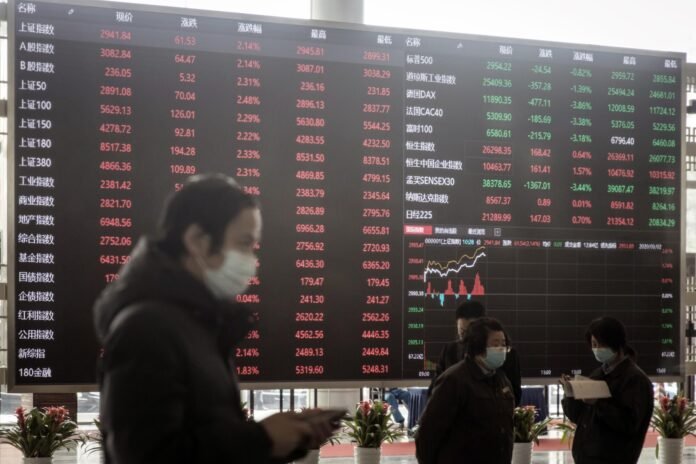Asian stocks experienced a decline following the release of Federal Reserve meeting minutes, contributing to a risk-off sentiment in the region. The weakness in China, coupled with indications of prolonged elevated interest rates, led to a third consecutive session of losses in the regional share gauge. Benchmark indices across Australia, South Korea, and China registered declines, while Japan’s Topix Index reversed early losses on the first trading day of the new year.
US stock futures in Asia posted marginal gains after the S&P 500 closed 0.8% lower on the previous day, extending a series of daily declines that began in the last trading session of 2023. The Nasdaq 100 reported its fourth consecutive daily drop, marking the longest losing streak in two months.
Investor attention is now focused on upcoming US jobs data, following hints from the Fed’s December meeting minutes suggesting that interest rates may remain at restrictive levels for an extended period. Swaps traders have adjusted their bets on rate cuts, reflecting reduced expectations for a quarter-point cut to the benchmark rate by the March meeting.

Jun Rong Yeap, Market Strategist at IG Asia Pte., noted, “The risk rally calls for a breather,” pointing to the unwinding of extreme bullish sentiments in Wall Street, a stronger US dollar, and higher oil prices as potential drags on Asian equities.
Chinese stocks experienced the most significant decline in Asia, driven by a report showing a record decline in wages offered to Chinese workers in major cities. Despite a private gauge indicating increased services activity in December, the CSI 300 benchmark extended its two-day decline, falling 1.4%.
Chinese government bond yields reached the lowest point in over three years, while the offshore yuan remained steady. The People’s Bank of China’s decision to weaken the currency fixing suggests a potential shift from stabilizing the currency to monetary easing. Chinese Finance Minister statements indicating increased government spending in the coming year were also noted.
The yen faced renewed pressure, trading over 143 per dollar, as a powerful earthquake complicates the Bank of Japan’s plans to abolish negative interest rates.
Treasuries exhibited stability in Asia after experiencing declines on one of the worst opening days to a year on record. The 10-year Treasury yield inched one basis point lower to 3.9% following the Fed minutes.
Geopolitical tensions remained in focus, with Iran attributing recent attacks to punish its stance against Israel, intensifying regional tensions. This development, along with supply disruptions in Libya and OPEC’s commitment to stabilizing prices, supported crude oil prices.
Bitcoin saw a significant slump, erasing most gains made in the new year, while gold edged higher.
The coming days will feature key economic indicators, including Eurozone Services PMI, US initial jobless claims and ADP employment data, Eurozone CPI and PPI, US nonfarm payrolls, unemployment, factory orders, and ISM services index. Richmond Fed President Tom Barkin is also scheduled to speak on Friday.
Some of the main market moves include:
Stocks:
- S&P 500 futures gain 0.1%
- Nasdaq 100 futures rose 0.1%
- Japan’s Topix rose 0.4%
- Australia’s S&P/ASX 200 fell 0.3%
- Hong Kong’s Hang Seng fell 0.5%
- The Shanghai Composite fell 0.9%
Currencies:
- The Bloomberg Dollar Spot Index was little changed
- The euro was little changed at $1.0927
- The Japanese yen was little changed at 143.43 per dollar
- The offshore yuan was little changed at 7.1645 per dollar
Cryptocurrencies:
- Bitcoin rose 0.5% to $43,143.39
- Ether rose 0.4% to $2,236.61
Bonds:
- The yield on 10-year Treasuries advanced one basis point to 3.93%
- Australia’s 10-year yield declined one basis point to 4.03%
Commodities:
- West Texas Intermediate crude rose 0.7% to $73.19 a barrel
- Spot gold rose 0.1% to $2,044.24 an ounce
The market dynamics indicate a cautious sentiment in the wake of the Fed minutes, coupled with geopolitical uncertainties and developments in various asset classes shaping the global economic landscape.




